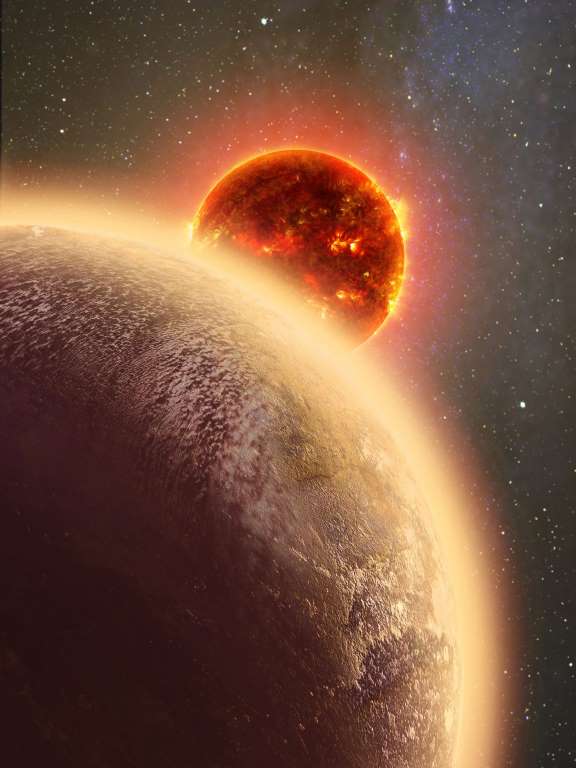November 12, 2015
A rocky Earth-sized planet that circles a small, nearby star could be the most important world ever found beyond the solar system, astronomers say.

November 12, 2015
A rocky Earth-sized planet that circles a small, nearby star could be the most important world ever found beyond the solar system, astronomers say.

This artist’s conception made by Dana Berry of SkyWorks and provided by NASA on Nov. 6, 2015 shows GJ 1132b, foreground, a rocky planet similar to the Earth in size and mass, orbiting a red dwarf star. The planet is 39 light-years away – within the atmospheric study range of the Hubble Space Telescope. "If we find this pretty hot planet has managed to hang onto its atmosphere over the billions of years it's been around, that bodes well for the long-term goal of studying cooler planets that could have life," said Massachusetts Institute of Technology's Zachory Berta-Thompson.
The planet lies in the constellation of Vela in the southern sky and is close enough for telescopes to observe any atmosphere it has, a procedure that could help spot life on other planets in the future.
Named GJ 1132b, the alien world is about 16% larger than Earth, and at 39 light years distant, is three times closer than any other Earth-sized rocky planet yet found around another star. At that distance, it is hoped that telescopes will be able to make out the chemistry of its atmosphere, the speed of its winds and the colours of its sunsets.
Astronomers spotted the planet as it moved across the face of a red dwarf star only a fifth the size of the sun. Though much cooler and fainter than the sun, GJ 1132b orbits so close to its star that surface temperatures reach 260C.
The searing temperatures are too hot for the surface to retain liquid water, making it inhospitable to life, but not so hot as to burn off any atmosphere that formed on the planet.
“If this planet still has an atmosphere, then we might find other, cooler planets that also have atmospheres and orbit small stars. We can then imagine interrogating the atmospheres for molecules that come from life,” said Zachory Berta-Thompson at the MIT’s Kavli Institute for Astrophysics and Space Research.
Researchers used the MEarth-South array, a group of eight 40cm robotic telescopes at the Cerro-Tololo Inter-American Observatory in Chile, to detect the planet. As it whipped around its star, completing an orbit every 1.6 days, it produced a faint 0.3% dip in the starlight picked up by the telescopes, according to a report in Nature.
The planet is tidally locked to its star, much as the moon is to Earth, and has one face in permanent daylight, the other in darkness. Given the world’s size and mass, researchers suspect it is rocky, like the inner planets of our solar system. It orbits 1.4m miles from its star, far closer than Mercury, which is never less than 36m miles from the sun.
Because the red dwarf is so small, and the planet is on such a close orbit, astronomers should find it fairly easy to detect and study any atmosphere the world has. The team has already requested time on the Hubble and Spitzer space telescopes to observe the planet in more detail.
Drake Deming, an astronomer at the University of Maryland, said GJ 1132b was “arguably the most important planet ever found outside the solar system”. Its proximity and orbit around a red dwarf will allow astronomers to study the planet with unprecedented fidelity. “It’s nearby, it’s Earth-like, and its star won’t interfere,” Drake said.
“GJ 1132b is too warm to be habitable, but scientists have yet to fully explore our cosmic neighborhood for worlds that potentially harbor life,” he notes in an accompanying article in Nature.
The planet will become a prime target for future missions too, including the James Webb Space Telescope, which is expected to launch in 2018, and the Giant Magellan Telescope, which is due to start operations in Chile in 2025.
The discovery came as scientists announced they had found the most distant object in the solar system, a frozen body that lies more than 100 times farther from the Sun than Earth does. The object lies beyond the edge of the Kuiper belt, home to the dwarf planet Pluto, and into the realm of space dominated by the so-called Oort cloud, a vast shell of icy objects where comets such as Hale-Bopp are thought to have formed.
Spotted from the Subaru telescope on Mauna Kea in Hawaii, the distant object is at least 500km across, but has not been tracked long enough to work out the full path of its orbit.
Courtesy: The Guardian















































































































